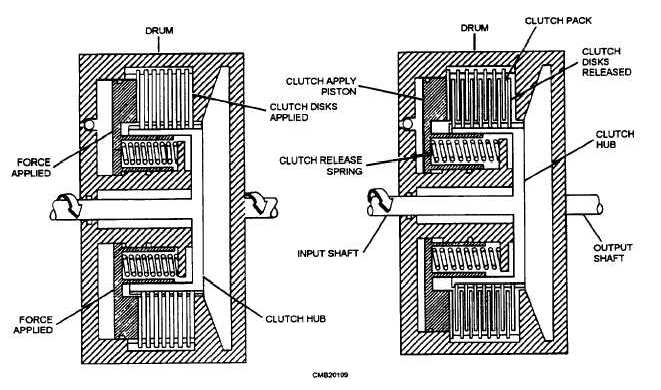PRESSURE PLATE. - The pressure plates are thick clutch plates that are placed on either end of the stack. Their purpose is to distribute the application pressure equally on the surfaces of the clutch discs and plates.
CLUTCH PISTON. - The clutch piston uses hydraulic pressure to apply the clutch. Hydraulic pressure is supplied to the clutch piston through the center of the rotating member.
CLUTCH PISTON SEALS. - The clutch piston seals serve to prevent the leakage of hydraulic pressure around the inner and outer circumferences of the clutch piston.
CLUTCH SPRINGS. - The clutch springs ensure rapid release of the clutch when hydraulic pressure to the clutch piston is released. The clutch springs may be in the form of several coil springs equally spaced around the piston or one large coil spring that fits in the center of the clutch drum. Some models use a diaphragm-type clutch spring.
The operation of the multiple-disc clutch is as follows (fig. 4-32):
RELEASED - When the clutch is released, there is no hydraulic pressure on the clutch piston and the clutch discs and plates are free to rotate within each other. The result is that the clutch hub rotates freely and does not drive the clutch drum.
APPLIED - When the clutch is applied, hydraulic pressure is applied to the clutch piston that, in turn, applies pressure to the clutch discs and plates, causing them to lock together. The result is that the clutch hub drives the clutch drum through the clutch.
Overrunning Clutch
An overrunning clutch is used in automatic transmissions to lock a planetary gearset to the transmission case so that it can act as a reactionary member. The overrunning clutch for the planetary gears is similar to the one in a torque converter stator or an electric starting motor drive gear. A planetary gearset overrunning clutch consists of an inner race, set of springs, rollers, and an outer race.
Operation of the overrunning clutch is very simple to understand. When driven in one direction, rollers lock between ramps on the inner and outer race, allowing both races to turn. This action can be used to stop movement of the planetary member, for example. When turned in the other direction, rollers walk off the ramps, and the races are free to turn independently.

Figure 4-32. - Multiple-disc clutch operation.
Continue Reading